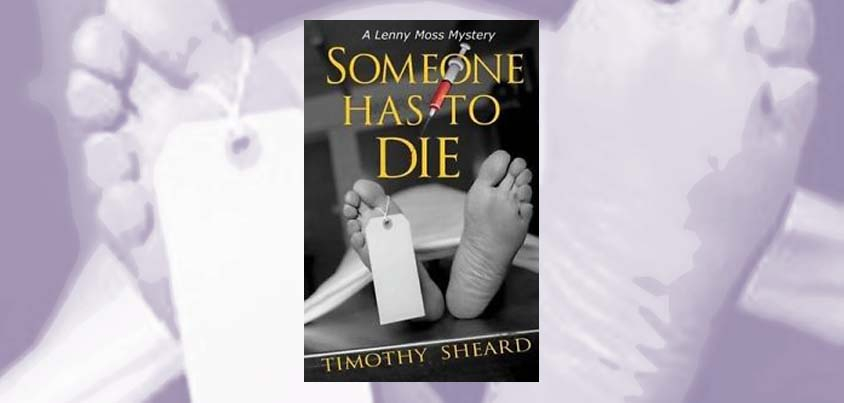Review: Hospital Gumshoe Cracks a How-Dunit

The detective in this series is a custodian and union steward. Someone Has to Die by Timothy Sheard, Hard Ball Press, 2016, $15.
The first problem that confronts the writer of a murder mystery series is how the protagonist manages to get drawn into so many murders. No wonder most protagonists are police investigators or private eyes. It’s what I think of as the Miss Marple Problem—how can so many people get murdered in the quiet little village of St. Mary Mead, anyway?
Timothy Sheard solves the Miss Marple Problem by setting his mysteries in a hospital, where deaths are common. His hero, Lenny Moss, is a custodian and union steward. Lenny has duties all over the hospital, contacts with and help from members, and a reputation as a sympathetic, supportive problem-solver. All this makes a sideline in detection feasible for him. Someone Has to Die is Lenny’s seventh case.
The mystery this time is a variant on the locked-room genre. A patient dies the night before he’s due to be discharged, and Anna Louise, a newly hired nurse, is blamed. Rigor mortis has set in by morning, contradicting her statement that the patient was sleeping peacefully when she checked on him during the night.
She is accused first of lying, and then of having caused his death by administering the wrong medicine. We believe Anna Louise, but the medical evidence is against her. So the mystery is not just a whodunit, but also a how-dunit.
CUSTODIAN’S-EYE VIEW
In the process of finding out, we learn a lot about medicine and hospital procedure. One of the joys of the mystery genre is getting an education about the routines and perspectives of people you might not otherwise know.
Seeing the hospital from Lenny’s perspective is eye-opening. I came away with a new appreciation of the importance of custodial staff in a hospital, where good housekeeping means more than just maintaining a neat environment. Careful handling of potentially infectious materials is crucial to making sure patients get well, instead of sicker, in the age of super-bugs. Lenny is savvy about infection dangers and conscientious in his duties. He is rightfully proud of his role in patient care.
Sheard also shows how solidarity among front-line workers is particularly crucial in a modern corporate hospital, since managers and administrators live in a whole different world. They’re handsomely rewarded for containing costs, which translates into constant attacks on wages and benefits. Their evaluations and bonuses depend on squeezing more work, at lower costs, from patient-care staff.
Sheard illustrates how to resist these pressures, weaving lessons on organizing strategy into the story. The union president is a powerful agitator and strategic thinker. We see him rescue a meeting that’s teetering on the edge of meltdown. And although their contract forbids direct action at the worksite without a month’s notice, he and Lenny figure out a way to bring street heat without crossing that line.

SUPPORT LABOR NOTES
BECOME A MONTHLY DONOR
Give $10 a month or more and get our "Fight the Boss, Build the Union" T-shirt.
The workers in Lenny’s union have each other’s backs; they understand how solidarity across professions is advantageous for all. Through Lenny, Sheard shows how a conscientious steward can get people in different job categories talking to each other, so they see how their various responsibilities for patient care intertwine.
BATTLING THE ROBOTS
The novel also offers a critique of the exploding use of technology. While the characters appreciate having complete, up-to-the-minute data for their patients, they chafe at robot-ization and intrusive surveillance.
An overworked nurse worries about getting all her meds delivered within the tight window of time she’s allotted, knowing her movements are being tracked by the GPS unit she’s forced to wear. Doctors feel sidelined by an Advanced Diagnostic and Treatment Program, which takes in data on symptoms and test results and suggests likely diagnoses.
It’s a powerful tool, but also enables managers to rush doctors into the statistically most likely diagnosis. Doctors feel reduced to interpreters of computer output. This way they can cover more patients in a given amount of time—but the value of their experience is lost, the quality of their work life suffers, and their ability to teach the next generation of doctors is compromised.
Despite the up-to-date setting, Lenny’s world has the comfortable feel of a mid-century genre of mystery fiction—the type that features a goodhearted, street-smart hero and a band of loyal, smart-talking comrades.
It’s also a little mid-century in its gender roles. The leaders and strongest characters are male, with women taking secondary roles. Lenny needs more strong women in his life! I look forward to meeting a female union president or feisty nurse in the next Lenny Moss novel—which I hope will be soon.
Diane Morrison is an activist in the organizing campaign of University of Washington faculty and a member of the Seattle Labor Chorus.
Read more: Love a good labor-themed mystery novel? A Bitter Pill is Lenny Moss's previous case. The detective in Organize or Die is a union organizer herself. A miner's son tracks the ghosts that haunt coal country in One of Us. Other shop stewards investigate crimes in Murder of a Post Office Manager and Rainwood House Sings. And you'll find more favorites in our round-up "A Novel Idea: Fiction for Labor Activists."





